Challenges and Strategies for Effective Management of Global Teams
VerifiedAdded on 2020/03/07
|13
|2935
|47
Literature Review
AI Summary
This literature review examines the challenges multinational organizations face in managing global teams. It defines global teams and distinguishes them from related concepts like multinational and virtual teams. The review explores mechanisms for managing virtuality, including transactive memory systems, psychologically safe communication climates, and trust-building. It also delves into managing cultural diversity through cultural intelligence, cultural agility, and global mindsets. The core challenges discussed include geographical separation, knowledge sharing, time and attention management, and cultural differences. The implications for International Human Resource Management (IHRM) are highlighted, emphasizing the importance of addressing cultural differences and virtuality challenges. The review also identifies gaps in the existing literature, particularly concerning financial and non-financial talent management parameters, the role of non-executive staff, and the importance of corporate culture and work-life balance within global teams.
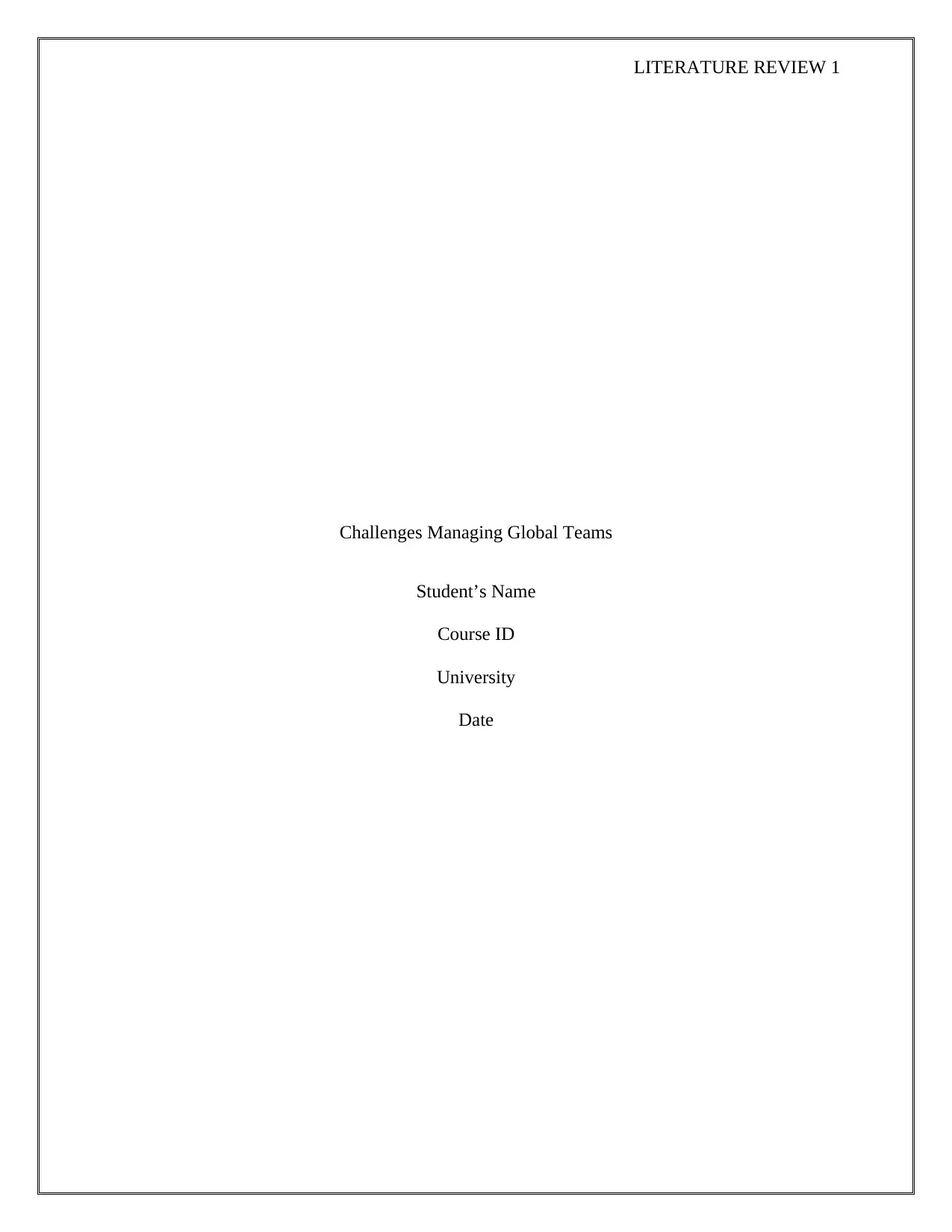
LITERATURE REVIEW 1
Challenges Managing Global Teams
Student’s Name
Course ID
University
Date
Challenges Managing Global Teams
Student’s Name
Course ID
University
Date
Paraphrase This Document
Need a fresh take? Get an instant paraphrase of this document with our AI Paraphraser

LITERATURE REVIEW 2
Table of Contents
Introduction......................................................................................................................................3
Defining Global Teams....................................................................................................................3
Managing virtuality and cultural diversity in global teams.............................................................4
Mechanism for managing virtuality.............................................................................................4
Mechanism for managing cultural diversity................................................................................5
Challenges in Managing Global Team............................................................................................7
Implications for IHRM....................................................................................................................9
Literature Gap..................................................................................................................................9
Conclusion.....................................................................................................................................10
References......................................................................................................................................11
Table of Contents
Introduction......................................................................................................................................3
Defining Global Teams....................................................................................................................3
Managing virtuality and cultural diversity in global teams.............................................................4
Mechanism for managing virtuality.............................................................................................4
Mechanism for managing cultural diversity................................................................................5
Challenges in Managing Global Team............................................................................................7
Implications for IHRM....................................................................................................................9
Literature Gap..................................................................................................................................9
Conclusion.....................................................................................................................................10
References......................................................................................................................................11
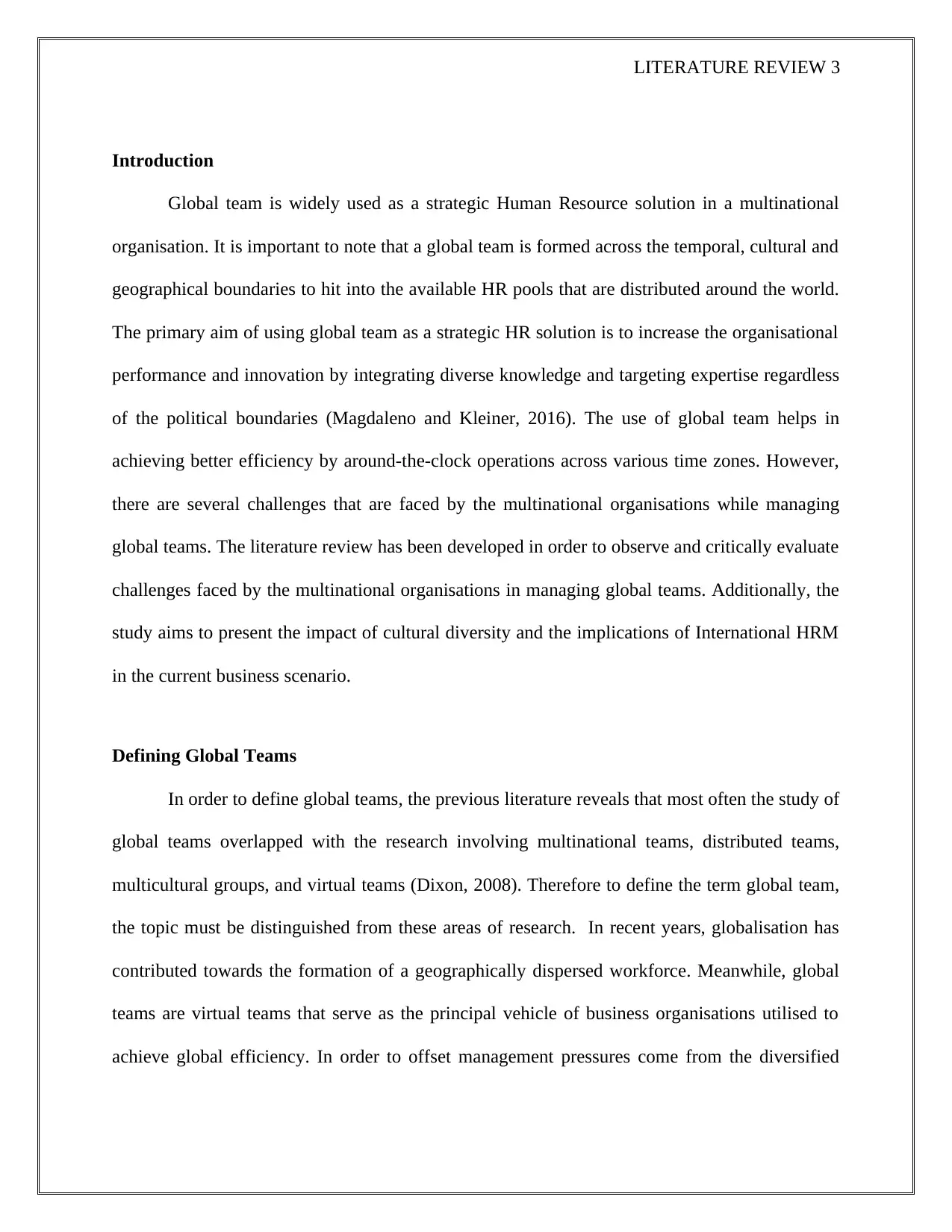
LITERATURE REVIEW 3
Introduction
Global team is widely used as a strategic Human Resource solution in a multinational
organisation. It is important to note that a global team is formed across the temporal, cultural and
geographical boundaries to hit into the available HR pools that are distributed around the world.
The primary aim of using global team as a strategic HR solution is to increase the organisational
performance and innovation by integrating diverse knowledge and targeting expertise regardless
of the political boundaries (Magdaleno and Kleiner, 2016). The use of global team helps in
achieving better efficiency by around-the-clock operations across various time zones. However,
there are several challenges that are faced by the multinational organisations while managing
global teams. The literature review has been developed in order to observe and critically evaluate
challenges faced by the multinational organisations in managing global teams. Additionally, the
study aims to present the impact of cultural diversity and the implications of International HRM
in the current business scenario.
Defining Global Teams
In order to define global teams, the previous literature reveals that most often the study of
global teams overlapped with the research involving multinational teams, distributed teams,
multicultural groups, and virtual teams (Dixon, 2008). Therefore to define the term global team,
the topic must be distinguished from these areas of research. In recent years, globalisation has
contributed towards the formation of a geographically dispersed workforce. Meanwhile, global
teams are virtual teams that serve as the principal vehicle of business organisations utilised to
achieve global efficiency. In order to offset management pressures come from the diversified
Introduction
Global team is widely used as a strategic Human Resource solution in a multinational
organisation. It is important to note that a global team is formed across the temporal, cultural and
geographical boundaries to hit into the available HR pools that are distributed around the world.
The primary aim of using global team as a strategic HR solution is to increase the organisational
performance and innovation by integrating diverse knowledge and targeting expertise regardless
of the political boundaries (Magdaleno and Kleiner, 2016). The use of global team helps in
achieving better efficiency by around-the-clock operations across various time zones. However,
there are several challenges that are faced by the multinational organisations while managing
global teams. The literature review has been developed in order to observe and critically evaluate
challenges faced by the multinational organisations in managing global teams. Additionally, the
study aims to present the impact of cultural diversity and the implications of International HRM
in the current business scenario.
Defining Global Teams
In order to define global teams, the previous literature reveals that most often the study of
global teams overlapped with the research involving multinational teams, distributed teams,
multicultural groups, and virtual teams (Dixon, 2008). Therefore to define the term global team,
the topic must be distinguished from these areas of research. In recent years, globalisation has
contributed towards the formation of a geographically dispersed workforce. Meanwhile, global
teams are virtual teams that serve as the principal vehicle of business organisations utilised to
achieve global efficiency. In order to offset management pressures come from the diversified
⊘ This is a preview!⊘
Do you want full access?
Subscribe today to unlock all pages.

Trusted by 1+ million students worldwide

LITERATURE REVIEW 4
target audience demand, converging markets, and resource allocation, organisation management
has developed global teams.
Modern business dynamics and internationalisation of businesses have emerged global
teams to proliferate best operations and practices in the overseas markets. Evidently, in the
twenty-first century, complex strategic business interventions have been managed and executed
through global teams achieving sustainability and growth at the global stage (Araujo, 2009).
Global teams are multinational working teams where team members are interconnected in a
virtual note. Decisively, global teams have been geographically distributed and it requires
significant knowledge and management skills to overcome the challenges of managing global
teams operating at the different corners of the world.
Managing virtuality and cultural diversity in global teams
Managing global teams can be identified as one of the most difficult tasks in human
resource management in compared to traditional teams (Hansen, Hope and Moehler, 2012). As
global teams embed multiple geographical contexts, diversified cultural background, different
time zones, and use of multiple communication technologies, the complexity of managing the
teams is far trickier (Dixon and Panteli, 2010). Before reviewing the challenges of managing
global teams, it is important to evaluate the methods of managing virtuality and diversity in
global teams on the basis of previous literature. Scholars have evaluated a number of
mechanisms that have been illustrated in the following section for managing virtuality and
diversity in global teams.
target audience demand, converging markets, and resource allocation, organisation management
has developed global teams.
Modern business dynamics and internationalisation of businesses have emerged global
teams to proliferate best operations and practices in the overseas markets. Evidently, in the
twenty-first century, complex strategic business interventions have been managed and executed
through global teams achieving sustainability and growth at the global stage (Araujo, 2009).
Global teams are multinational working teams where team members are interconnected in a
virtual note. Decisively, global teams have been geographically distributed and it requires
significant knowledge and management skills to overcome the challenges of managing global
teams operating at the different corners of the world.
Managing virtuality and cultural diversity in global teams
Managing global teams can be identified as one of the most difficult tasks in human
resource management in compared to traditional teams (Hansen, Hope and Moehler, 2012). As
global teams embed multiple geographical contexts, diversified cultural background, different
time zones, and use of multiple communication technologies, the complexity of managing the
teams is far trickier (Dixon and Panteli, 2010). Before reviewing the challenges of managing
global teams, it is important to evaluate the methods of managing virtuality and diversity in
global teams on the basis of previous literature. Scholars have evaluated a number of
mechanisms that have been illustrated in the following section for managing virtuality and
diversity in global teams.
Paraphrase This Document
Need a fresh take? Get an instant paraphrase of this document with our AI Paraphraser

LITERATURE REVIEW 5
Mechanism for managing virtuality
Managing virtuality within the international teams must be handled in an efficient order
so that the virtuality of global team members cannot necessarily become berries in interactions.
Most importantly, scholars have identified some of the tested mechanism to manage virtuality in
global teams successfully. Traditionally, physical presence of team members has been vital in
team management. Due to emerging communication technologies and presence of internet,
managers now can efficiently control and monitor the performance of the global teams from any
place (Gibson and Gibbs, 2006). Evidently, three mechanisms for managing virtuality in global
teams have been reviewed in the study i.e. transactive memory systems (TMS), psychologically
safe communication climate (PSCC), and developing trust.
Transactive memory systems: Modern scholars have identified global teams as
networked systems worked for a firm. In such networked system, transactive memory
systems have been used as a primary mechanism to share knowledge within the global
teams. As team members develop effective TMS, accurate set of knowledge and
information can be transferred within the virtual teams influencing output (Hansen, Hope
and Moehler, 2012).
Psychologically safe communication climate: Gibson and Gibbs (2006) identified that
PSCC, an interpersonal process can be effectively utilised by the managers to negate the
adverse effect of virtuality of global teams. By developing such communication climate
within the global teams, a bridge of unity can be structured among the team members.
Developing Trust: In terms of managing the performance of global teams, building trust
can be defined as one of the major functional mechanisms improving efficiency of
workers. Through the development of trust among the virtual team members, the
Mechanism for managing virtuality
Managing virtuality within the international teams must be handled in an efficient order
so that the virtuality of global team members cannot necessarily become berries in interactions.
Most importantly, scholars have identified some of the tested mechanism to manage virtuality in
global teams successfully. Traditionally, physical presence of team members has been vital in
team management. Due to emerging communication technologies and presence of internet,
managers now can efficiently control and monitor the performance of the global teams from any
place (Gibson and Gibbs, 2006). Evidently, three mechanisms for managing virtuality in global
teams have been reviewed in the study i.e. transactive memory systems (TMS), psychologically
safe communication climate (PSCC), and developing trust.
Transactive memory systems: Modern scholars have identified global teams as
networked systems worked for a firm. In such networked system, transactive memory
systems have been used as a primary mechanism to share knowledge within the global
teams. As team members develop effective TMS, accurate set of knowledge and
information can be transferred within the virtual teams influencing output (Hansen, Hope
and Moehler, 2012).
Psychologically safe communication climate: Gibson and Gibbs (2006) identified that
PSCC, an interpersonal process can be effectively utilised by the managers to negate the
adverse effect of virtuality of global teams. By developing such communication climate
within the global teams, a bridge of unity can be structured among the team members.
Developing Trust: In terms of managing the performance of global teams, building trust
can be defined as one of the major functional mechanisms improving efficiency of
workers. Through the development of trust among the virtual team members, the

LITERATURE REVIEW 6
collaboration among the employees can be enhanced (Kelley, 2011). Thus, the
productivity of virtual team projects will be increased.
Mechanism for managing cultural diversity
Managing cultural diversity must be prioritised in global team management to attain
efficiency (Winkler and Bouncken, 2011). While some of the members of a team have efficiently
collaborated with other teammates from diverse culture and background, most of them have
failed to work together. Thus, the efficiency of managing cultural diversity may lead to
expatriate failure (Orhan, 2014). Lack of training and collaboration has forced expatriates to seek
a transfer from the host country leading towards operational failure (Wang, 2013). In order to
solve the problem of managing cultural diversity in global teams, scholars and researchers have
identified three mechanisms i.e. cultural intelligence, cultural agility, and global mindset.
Cultural Intelligence: Evidently, Scholars and modern researchers have claimed that
developing cultural intelligence can be imperative for contemporary management leaders
to succeed in the cross-cultural group effort (Magdaleno and Kleiner, 2016).
Understandably, cultural intelligence enhances interactions among the team members so
that different cultural barriers can be broken during developing global teams. Thus, the
output of the team will be increased.
Cultural Agility: Caligiuri (2012) elaborates cultural agility as a meta-competency
increases flexibility and performance of the professionals to work effectively in cross-
cultural circumstances. Having cultural agility, global team members can influence their
work efficiency in alien cultural norms (Caligiuri, 2012). Furthermore, cultural agility
must be developed as a recommended skill for management personnel working with
global teams.
collaboration among the employees can be enhanced (Kelley, 2011). Thus, the
productivity of virtual team projects will be increased.
Mechanism for managing cultural diversity
Managing cultural diversity must be prioritised in global team management to attain
efficiency (Winkler and Bouncken, 2011). While some of the members of a team have efficiently
collaborated with other teammates from diverse culture and background, most of them have
failed to work together. Thus, the efficiency of managing cultural diversity may lead to
expatriate failure (Orhan, 2014). Lack of training and collaboration has forced expatriates to seek
a transfer from the host country leading towards operational failure (Wang, 2013). In order to
solve the problem of managing cultural diversity in global teams, scholars and researchers have
identified three mechanisms i.e. cultural intelligence, cultural agility, and global mindset.
Cultural Intelligence: Evidently, Scholars and modern researchers have claimed that
developing cultural intelligence can be imperative for contemporary management leaders
to succeed in the cross-cultural group effort (Magdaleno and Kleiner, 2016).
Understandably, cultural intelligence enhances interactions among the team members so
that different cultural barriers can be broken during developing global teams. Thus, the
output of the team will be increased.
Cultural Agility: Caligiuri (2012) elaborates cultural agility as a meta-competency
increases flexibility and performance of the professionals to work effectively in cross-
cultural circumstances. Having cultural agility, global team members can influence their
work efficiency in alien cultural norms (Caligiuri, 2012). Furthermore, cultural agility
must be developed as a recommended skill for management personnel working with
global teams.
⊘ This is a preview!⊘
Do you want full access?
Subscribe today to unlock all pages.

Trusted by 1+ million students worldwide

LITERATURE REVIEW 7
Global Mindset: Global mindset can be addressed as a mechanism that influences the
sense of responsibility of the global team members avoiding diverse cultural barriers. A
global mindset of international human resource managers can be utilised to adapt
different cultural orientation to develop a positive frame of mind among the team
members.
Challenges in Managing Global Team
According to Armstrong and Cole (2002), the multinational corporations face several
communication challenges while managing global teams. The low level of nonverbal and
physical cues available in technologically mediated and geographically distributed workforce
have created different challenges such as difficulty of sharing knowledge and faulty attribution
of others (Kelley, 2011). The distribution of workforce across space, time and multiple groups
creates challenge in managing attention and time among the multiple commitments that further
results in high level of stress among the executive members. Furthermore, the presence of
multiple culture and differences in ethical practices results in conflict and faultiness among the
team members belonging to different nations and cultures due to the variation in attitudes,
behaviour, values and broader institutional environments. The primary challenges that are faced
while managing global teams are discussed in details herein below:
Geographical separation: The geographical separation may lead to lack of mutual
knowledge among the team members about each others’ situations and way of working
that further leads to faulty attribution about the other team members (Kelley, 2011). It has
been found through research that distributed team members are likely to make negative
acknowledgments about the colleagues from other zones due to lack of situational
Global Mindset: Global mindset can be addressed as a mechanism that influences the
sense of responsibility of the global team members avoiding diverse cultural barriers. A
global mindset of international human resource managers can be utilised to adapt
different cultural orientation to develop a positive frame of mind among the team
members.
Challenges in Managing Global Team
According to Armstrong and Cole (2002), the multinational corporations face several
communication challenges while managing global teams. The low level of nonverbal and
physical cues available in technologically mediated and geographically distributed workforce
have created different challenges such as difficulty of sharing knowledge and faulty attribution
of others (Kelley, 2011). The distribution of workforce across space, time and multiple groups
creates challenge in managing attention and time among the multiple commitments that further
results in high level of stress among the executive members. Furthermore, the presence of
multiple culture and differences in ethical practices results in conflict and faultiness among the
team members belonging to different nations and cultures due to the variation in attitudes,
behaviour, values and broader institutional environments. The primary challenges that are faced
while managing global teams are discussed in details herein below:
Geographical separation: The geographical separation may lead to lack of mutual
knowledge among the team members about each others’ situations and way of working
that further leads to faulty attribution about the other team members (Kelley, 2011). It has
been found through research that distributed team members are likely to make negative
acknowledgments about the colleagues from other zones due to lack of situational
Paraphrase This Document
Need a fresh take? Get an instant paraphrase of this document with our AI Paraphraser
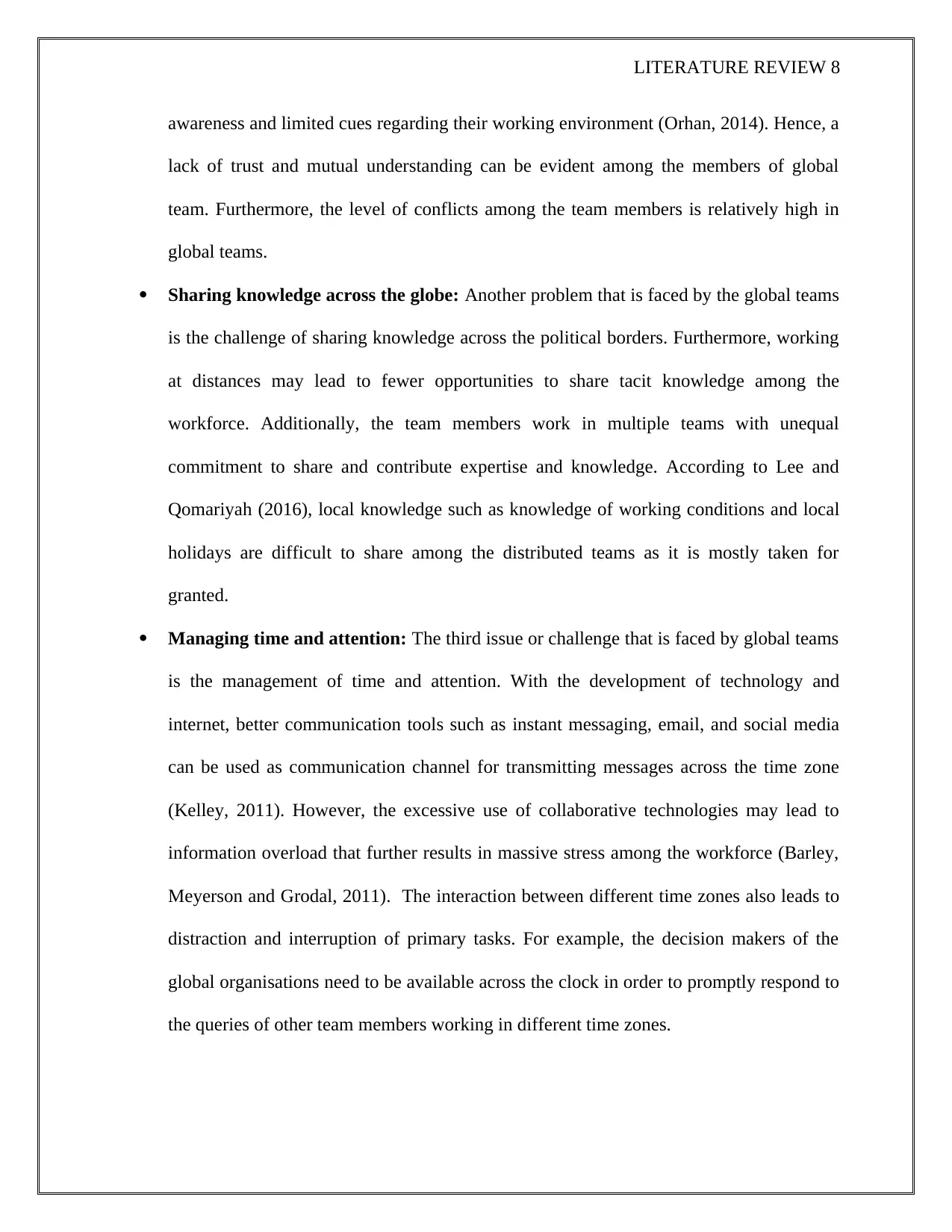
LITERATURE REVIEW 8
awareness and limited cues regarding their working environment (Orhan, 2014). Hence, a
lack of trust and mutual understanding can be evident among the members of global
team. Furthermore, the level of conflicts among the team members is relatively high in
global teams.
Sharing knowledge across the globe: Another problem that is faced by the global teams
is the challenge of sharing knowledge across the political borders. Furthermore, working
at distances may lead to fewer opportunities to share tacit knowledge among the
workforce. Additionally, the team members work in multiple teams with unequal
commitment to share and contribute expertise and knowledge. According to Lee and
Qomariyah (2016), local knowledge such as knowledge of working conditions and local
holidays are difficult to share among the distributed teams as it is mostly taken for
granted.
Managing time and attention: The third issue or challenge that is faced by global teams
is the management of time and attention. With the development of technology and
internet, better communication tools such as instant messaging, email, and social media
can be used as communication channel for transmitting messages across the time zone
(Kelley, 2011). However, the excessive use of collaborative technologies may lead to
information overload that further results in massive stress among the workforce (Barley,
Meyerson and Grodal, 2011). The interaction between different time zones also leads to
distraction and interruption of primary tasks. For example, the decision makers of the
global organisations need to be available across the clock in order to promptly respond to
the queries of other team members working in different time zones.
awareness and limited cues regarding their working environment (Orhan, 2014). Hence, a
lack of trust and mutual understanding can be evident among the members of global
team. Furthermore, the level of conflicts among the team members is relatively high in
global teams.
Sharing knowledge across the globe: Another problem that is faced by the global teams
is the challenge of sharing knowledge across the political borders. Furthermore, working
at distances may lead to fewer opportunities to share tacit knowledge among the
workforce. Additionally, the team members work in multiple teams with unequal
commitment to share and contribute expertise and knowledge. According to Lee and
Qomariyah (2016), local knowledge such as knowledge of working conditions and local
holidays are difficult to share among the distributed teams as it is mostly taken for
granted.
Managing time and attention: The third issue or challenge that is faced by global teams
is the management of time and attention. With the development of technology and
internet, better communication tools such as instant messaging, email, and social media
can be used as communication channel for transmitting messages across the time zone
(Kelley, 2011). However, the excessive use of collaborative technologies may lead to
information overload that further results in massive stress among the workforce (Barley,
Meyerson and Grodal, 2011). The interaction between different time zones also leads to
distraction and interruption of primary tasks. For example, the decision makers of the
global organisations need to be available across the clock in order to promptly respond to
the queries of other team members working in different time zones.

LITERATURE REVIEW 9
Cultural Differences: The last and the most important challenge faced by the members
of global teams are the cultural differences among the employees. According to Hofstede
(2005), the members of global team can be differentiated as individualist and collectivist,
high context and low context, and feminine and masculine on the basis of their culture
and ethical practices. Cultural conflicts can be seen in several cases across the globe,
which has emerged to be a major challenge for international human resource management
(Orhan, 2014). Hence, it is important for the manager of an international team to
understand the cultural differences and give equal importance to individual cultural
believes to maintain peace and harmony among the global teams.
Implications for IHRM
On the basis of the above analysis, the International Human Resource (IHR) managers
needs to attend and overcome the challenges related to cultural differences of the global team
members as well as challenges related to virtuality such as knowledge sharing across the political
contexts, faulty attributions, and managing time and attention in order to improve the
effectiveness of the global teams (Winkler and Bouncken, 2011). The IHR manager plays a key
role in training the global team members and leaders by developing transactive memory systems
(TMS), psychologically safe communication climate (PSCC), and trust. Such techniques will
help the multinational organisations to overcome challenges of virtuality and enhance employee
productivity and satisfaction (Palthe, 2014). IHRM helps in developing global skills among the
leaders to manage global mindset, cultural diversity and cultural intelligence. Hence, the
challenges of managing global teams can be overcome by implementing IHRM strategies in the
multinational organisations.
Cultural Differences: The last and the most important challenge faced by the members
of global teams are the cultural differences among the employees. According to Hofstede
(2005), the members of global team can be differentiated as individualist and collectivist,
high context and low context, and feminine and masculine on the basis of their culture
and ethical practices. Cultural conflicts can be seen in several cases across the globe,
which has emerged to be a major challenge for international human resource management
(Orhan, 2014). Hence, it is important for the manager of an international team to
understand the cultural differences and give equal importance to individual cultural
believes to maintain peace and harmony among the global teams.
Implications for IHRM
On the basis of the above analysis, the International Human Resource (IHR) managers
needs to attend and overcome the challenges related to cultural differences of the global team
members as well as challenges related to virtuality such as knowledge sharing across the political
contexts, faulty attributions, and managing time and attention in order to improve the
effectiveness of the global teams (Winkler and Bouncken, 2011). The IHR manager plays a key
role in training the global team members and leaders by developing transactive memory systems
(TMS), psychologically safe communication climate (PSCC), and trust. Such techniques will
help the multinational organisations to overcome challenges of virtuality and enhance employee
productivity and satisfaction (Palthe, 2014). IHRM helps in developing global skills among the
leaders to manage global mindset, cultural diversity and cultural intelligence. Hence, the
challenges of managing global teams can be overcome by implementing IHRM strategies in the
multinational organisations.
⊘ This is a preview!⊘
Do you want full access?
Subscribe today to unlock all pages.

Trusted by 1+ million students worldwide
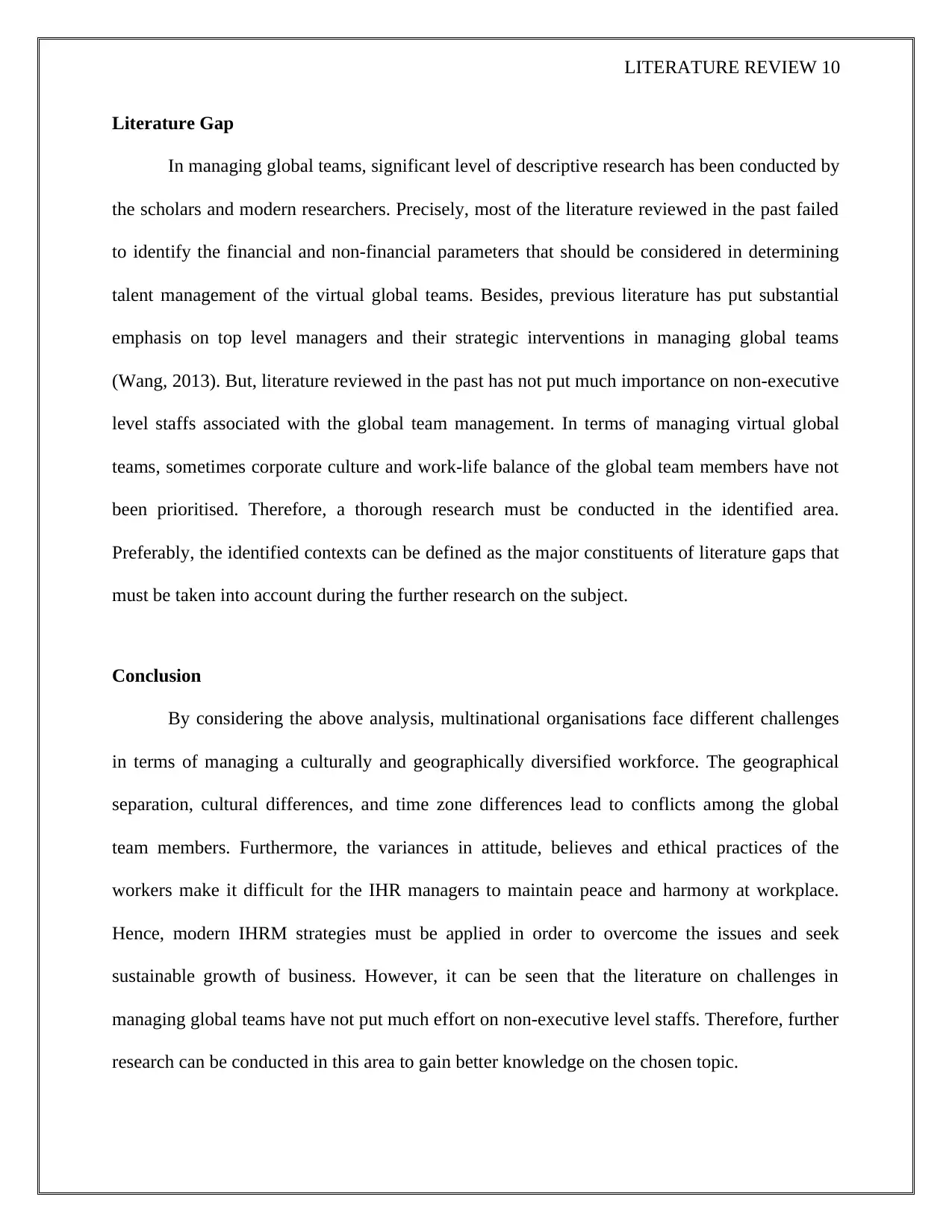
LITERATURE REVIEW 10
Literature Gap
In managing global teams, significant level of descriptive research has been conducted by
the scholars and modern researchers. Precisely, most of the literature reviewed in the past failed
to identify the financial and non-financial parameters that should be considered in determining
talent management of the virtual global teams. Besides, previous literature has put substantial
emphasis on top level managers and their strategic interventions in managing global teams
(Wang, 2013). But, literature reviewed in the past has not put much importance on non-executive
level staffs associated with the global team management. In terms of managing virtual global
teams, sometimes corporate culture and work-life balance of the global team members have not
been prioritised. Therefore, a thorough research must be conducted in the identified area.
Preferably, the identified contexts can be defined as the major constituents of literature gaps that
must be taken into account during the further research on the subject.
Conclusion
By considering the above analysis, multinational organisations face different challenges
in terms of managing a culturally and geographically diversified workforce. The geographical
separation, cultural differences, and time zone differences lead to conflicts among the global
team members. Furthermore, the variances in attitude, believes and ethical practices of the
workers make it difficult for the IHR managers to maintain peace and harmony at workplace.
Hence, modern IHRM strategies must be applied in order to overcome the issues and seek
sustainable growth of business. However, it can be seen that the literature on challenges in
managing global teams have not put much effort on non-executive level staffs. Therefore, further
research can be conducted in this area to gain better knowledge on the chosen topic.
Literature Gap
In managing global teams, significant level of descriptive research has been conducted by
the scholars and modern researchers. Precisely, most of the literature reviewed in the past failed
to identify the financial and non-financial parameters that should be considered in determining
talent management of the virtual global teams. Besides, previous literature has put substantial
emphasis on top level managers and their strategic interventions in managing global teams
(Wang, 2013). But, literature reviewed in the past has not put much importance on non-executive
level staffs associated with the global team management. In terms of managing virtual global
teams, sometimes corporate culture and work-life balance of the global team members have not
been prioritised. Therefore, a thorough research must be conducted in the identified area.
Preferably, the identified contexts can be defined as the major constituents of literature gaps that
must be taken into account during the further research on the subject.
Conclusion
By considering the above analysis, multinational organisations face different challenges
in terms of managing a culturally and geographically diversified workforce. The geographical
separation, cultural differences, and time zone differences lead to conflicts among the global
team members. Furthermore, the variances in attitude, believes and ethical practices of the
workers make it difficult for the IHR managers to maintain peace and harmony at workplace.
Hence, modern IHRM strategies must be applied in order to overcome the issues and seek
sustainable growth of business. However, it can be seen that the literature on challenges in
managing global teams have not put much effort on non-executive level staffs. Therefore, further
research can be conducted in this area to gain better knowledge on the chosen topic.
Paraphrase This Document
Need a fresh take? Get an instant paraphrase of this document with our AI Paraphraser

LITERATURE REVIEW 11
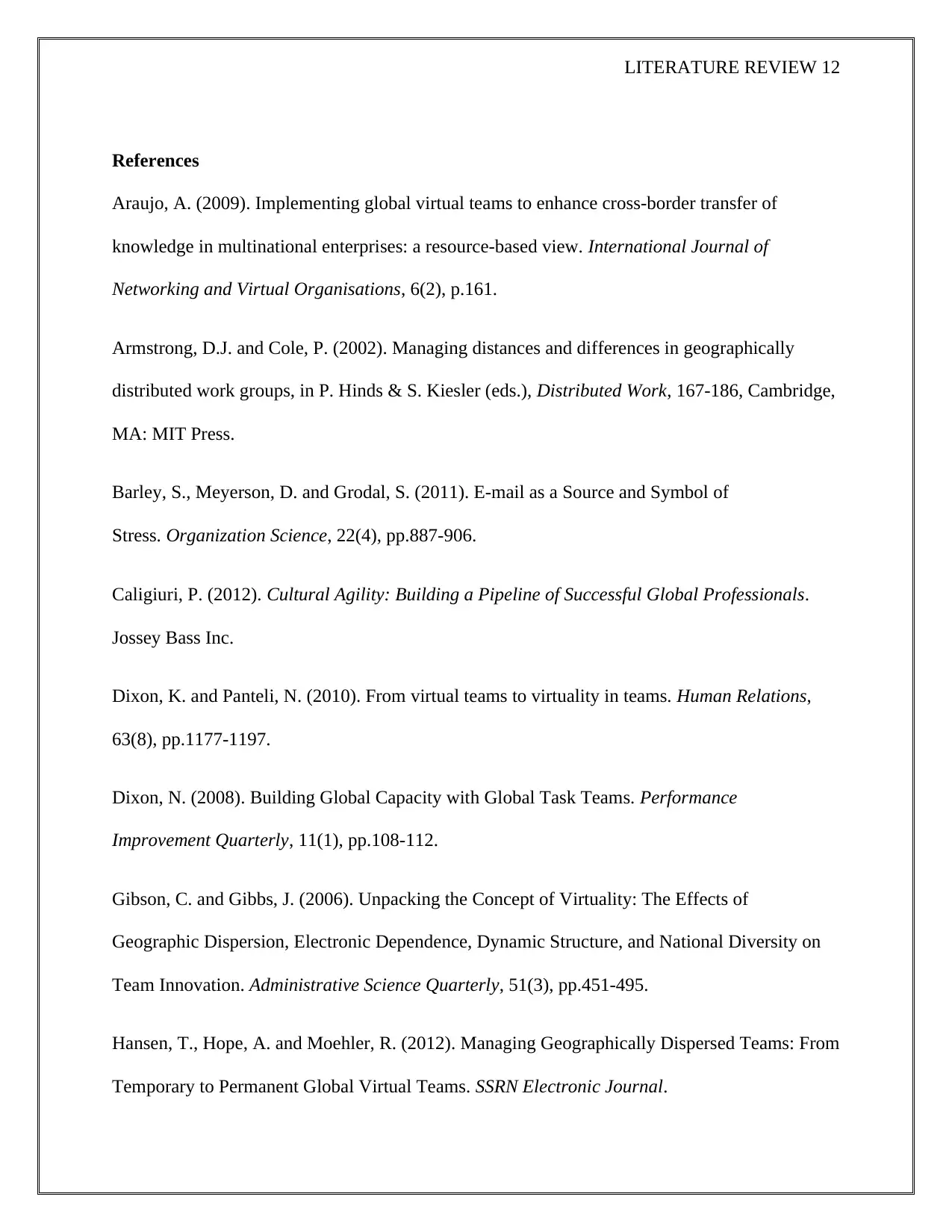
LITERATURE REVIEW 12
References
Araujo, A. (2009). Implementing global virtual teams to enhance cross-border transfer of
knowledge in multinational enterprises: a resource-based view. International Journal of
Networking and Virtual Organisations, 6(2), p.161.
Armstrong, D.J. and Cole, P. (2002). Managing distances and differences in geographically
distributed work groups, in P. Hinds & S. Kiesler (eds.), Distributed Work, 167-186, Cambridge,
MA: MIT Press.
Barley, S., Meyerson, D. and Grodal, S. (2011). E-mail as a Source and Symbol of
Stress. Organization Science, 22(4), pp.887-906.
Caligiuri, P. (2012). Cultural Agility: Building a Pipeline of Successful Global Professionals.
Jossey Bass Inc.
Dixon, K. and Panteli, N. (2010). From virtual teams to virtuality in teams. Human Relations,
63(8), pp.1177-1197.
Dixon, N. (2008). Building Global Capacity with Global Task Teams. Performance
Improvement Quarterly, 11(1), pp.108-112.
Gibson, C. and Gibbs, J. (2006). Unpacking the Concept of Virtuality: The Effects of
Geographic Dispersion, Electronic Dependence, Dynamic Structure, and National Diversity on
Team Innovation. Administrative Science Quarterly, 51(3), pp.451-495.
Hansen, T., Hope, A. and Moehler, R. (2012). Managing Geographically Dispersed Teams: From
Temporary to Permanent Global Virtual Teams. SSRN Electronic Journal.
References
Araujo, A. (2009). Implementing global virtual teams to enhance cross-border transfer of
knowledge in multinational enterprises: a resource-based view. International Journal of
Networking and Virtual Organisations, 6(2), p.161.
Armstrong, D.J. and Cole, P. (2002). Managing distances and differences in geographically
distributed work groups, in P. Hinds & S. Kiesler (eds.), Distributed Work, 167-186, Cambridge,
MA: MIT Press.
Barley, S., Meyerson, D. and Grodal, S. (2011). E-mail as a Source and Symbol of
Stress. Organization Science, 22(4), pp.887-906.
Caligiuri, P. (2012). Cultural Agility: Building a Pipeline of Successful Global Professionals.
Jossey Bass Inc.
Dixon, K. and Panteli, N. (2010). From virtual teams to virtuality in teams. Human Relations,
63(8), pp.1177-1197.
Dixon, N. (2008). Building Global Capacity with Global Task Teams. Performance
Improvement Quarterly, 11(1), pp.108-112.
Gibson, C. and Gibbs, J. (2006). Unpacking the Concept of Virtuality: The Effects of
Geographic Dispersion, Electronic Dependence, Dynamic Structure, and National Diversity on
Team Innovation. Administrative Science Quarterly, 51(3), pp.451-495.
Hansen, T., Hope, A. and Moehler, R. (2012). Managing Geographically Dispersed Teams: From
Temporary to Permanent Global Virtual Teams. SSRN Electronic Journal.
⊘ This is a preview!⊘
Do you want full access?
Subscribe today to unlock all pages.

Trusted by 1+ million students worldwide
1 out of 13
Related Documents
Your All-in-One AI-Powered Toolkit for Academic Success.
+13062052269
info@desklib.com
Available 24*7 on WhatsApp / Email
![[object Object]](/_next/static/media/star-bottom.7253800d.svg)
Unlock your academic potential
Copyright © 2020–2025 A2Z Services. All Rights Reserved. Developed and managed by ZUCOL.





